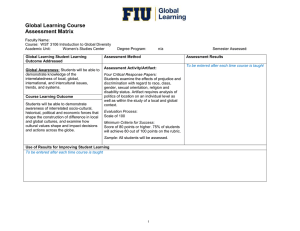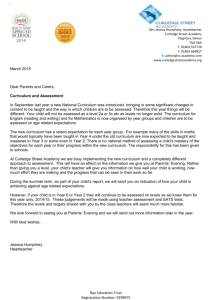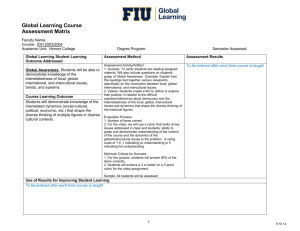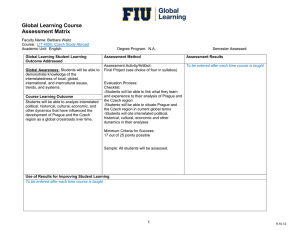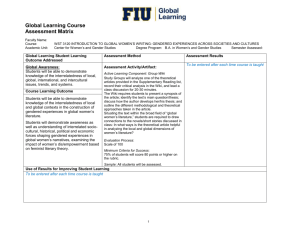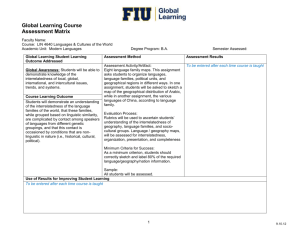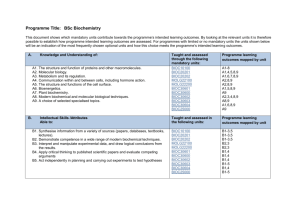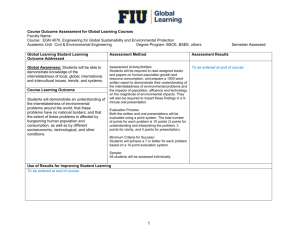Expanded Statement of Institutional Purpose
advertisement
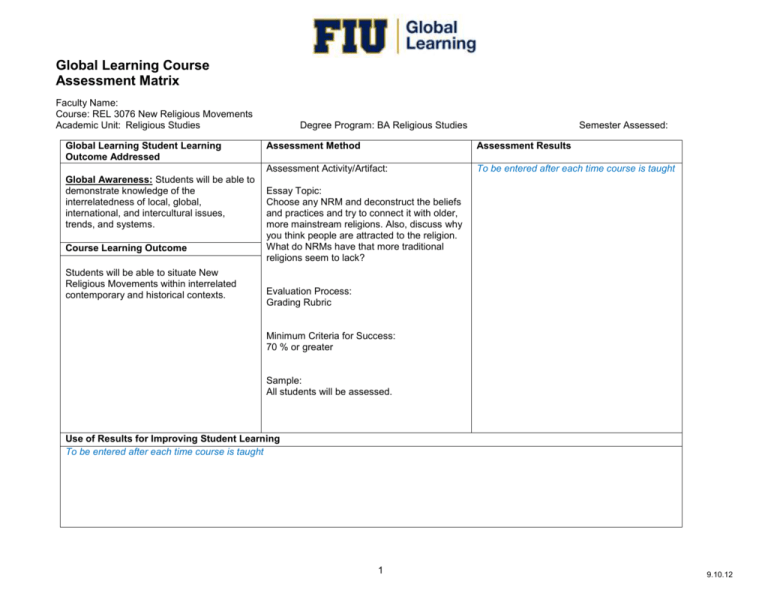
Global Learning Course Assessment Matrix Faculty Name: Course: REL 3076 New Religious Movements Academic Unit: Religious Studies Global Learning Student Learning Outcome Addressed Global Awareness: Students will be able to demonstrate knowledge of the interrelatedness of local, global, international, and intercultural issues, trends, and systems. Course Learning Outcome Students will be able to situate New Religious Movements within interrelated contemporary and historical contexts. Degree Program: BA Religious Studies Semester Assessed: Assessment Method Assessment Results Assessment Activity/Artifact: To be entered after each time course is taught Essay Topic: Choose any NRM and deconstruct the beliefs and practices and try to connect it with older, more mainstream religions. Also, discuss why you think people are attracted to the religion. What do NRMs have that more traditional religions seem to lack? Evaluation Process: Grading Rubric Minimum Criteria for Success: 70 % or greater Sample: All students will be assessed. Use of Results for Improving Student Learning To be entered after each time course is taught 1 9.10.12 Global Learning Course Assessment Matrix Faculty Name: Course: REL 3076 New Religious Movements Academic Unit: Religious Studies Global Learning Student Learning Outcome Addressed Degree Program: BA Religious Studies Semester Assessed: Assessment Method Assessment Results Assessment Activity/Artifact: Global Perspective: Students will be able to conduct a multi-perspective analysis of local, global, international, and intercultural problems. Course Learning Outcome Students will be able to develop an analysis of a core religious concept (e.g., the nature of God, reincarnation, karma, justice, etc.) via the perspective of multiple New Religious Movements. To be entered after each time course is taught Discussion Topic: Your text discusses several theories, including their own theory, on why people are attracted to NRMs. Explore some of the main reasons (spiritual, social networking, economic, emotional, etc.) why people might choose to join an NRM rather than a traditional religion. Make an argument about why you think most people would join an NRM. Imagine that you are writing from the perspective of someone in the religion. Try to convince others about why your position is correct. Evaluation Process: Grading Rubric Minimum Criteria for Success: 70% or greater Sample: All students will be assessed. Use of Results for Improving Student Learning To be entered after each time course is taught 2 9.10.12 Global Learning Course Assessment Matrix Faculty Name: Course: REL 3076 New Religious Movements Academic Unit: Religious Studies Global Learning Student Learning Outcome Addressed Degree Program: BA Religious Studies Assessment Method Assessment Activity/Artifact: Discussion Topic: In chapter three of their book, New Religions as Global Cultures, Hexham and Poewe frame their argument that New Religions are examples of “Global Cultures”, and contain both local or regional aspects, as well as global aspects. Course Learning Outcome They argue that these New Religions have developed in response to modernity and all the Students will demonstrate a willingness to accompanying technological and social engage in an ongoing dialogue about changes it brought. current global concerns in order to address One especially controversial issue related to problems arising from the interaction between global concerns and local religious these globalized New Religions is that of cultural appropriation versus cultural beliefs and practices as manifested in New appreciation. Create an argument either for or Religious Movements. against the borrowing of cultural symbols, practices, beliefs or ideas. Use examples from your own life, or from your community. Try to convince your classmates why your perspective on the issue is the correct one. Evaluation Process: Grading Rubric Minimum Criteria for Success: 70% or greater Sample: All students will be assessed. Use of Results for Improving Student Learning To be entered after each time course is taught Global Engagement: Students will be able to demonstrate willingness to engage in local, global, international, and intercultural problem solving. 3 Semester Assessed: Assessment Results To be entered after each time course is taught 9.10.12
